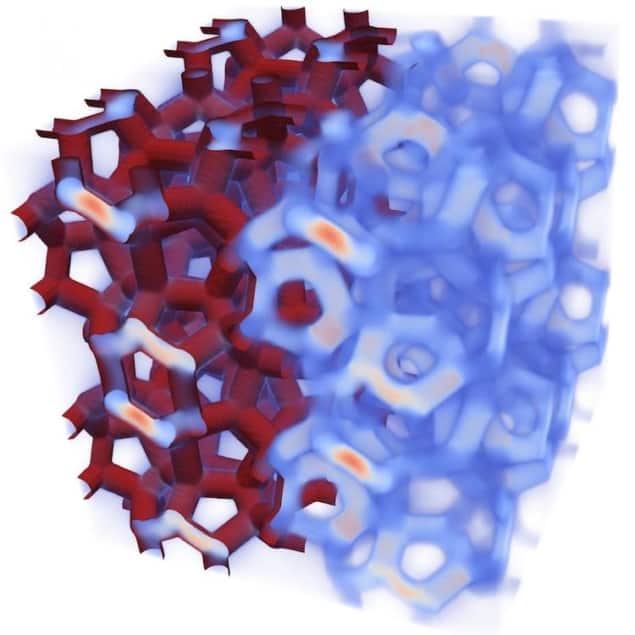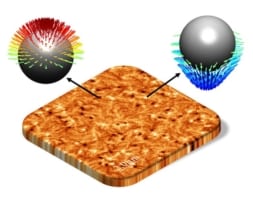
Scientists at Princeton University in the US have discovered that a material known as a Weaire-Phelan foam can act as an optical filter. As well as adding to our understanding of such foams, which have been studied for more than 130 years, the discovery might also spur the development of novel optical telecommunications devices.
Foams have a multitude of practical applications and are common ingredients in products ranging from chemical filters to heat exchangers. In mathematical terms, they are known for forming structures that minimize the surface area of the geometrical shapes, or cells, that make them up. It was this property that attracted the attention of the 19th-century Scottish physicist Lord Kelvin. In 1887, Kelvin proposed that the “luminiferous aether” thought to permeate all of space might have a foam-like structure. He then attempted to find the most efficient way of filling a 3D space by sub-dividing it into interlocking cells of equal volume and minimizing the surface area between cells. The resulting bubble-like structure came to be known as a Kelvin foam.
Extra efficient space-fillers
More than a century later, the Irish physicist Denis Weaire and his student Robert Phelan improved on Kelvin’s conjecture by putting forward an alternative arrangement that requires even less surface area. Although a Weaire-Phelan (WP) foam looks superficially similar to the disordered froth of soap bubbles or the head on a glass of beer, it is in fact a precisely structured arrangement containing two types of cells (as opposed to just one in Kelvin’s original proposal) of equal volumes. Twenty-five years after its discovery, a WP foam remains the most efficient space-filling ordered bubble foam known to exist.
3D photonic networks of foam edges
Much research has been done on WP foams and many of their physical properties are well-understood. The Princeton team of Michael Klatt, Paul Steinhardt and Salvatore Torquato, however, took a different approach, studying the optical properties of 3D photonic networks made from the edges of a WP foam, a Kelvin foam and another type of dry crystalline foam known as C15. Foams such as these contain very little liquid, and their edge structures are characterized by a set of relationships known as Plateau’s laws. These laws dictate that the borders of individual cells within the foam meet in sets of four, with tetrahedral bond angles equal to around 109° at each vertex. In principle, it would be possible to turn such edge structures into photonic networks by solidifying the foam and coating it with a dielectric material.
A photonic band gap
The team simulated Maxwell’s electromagnetic wave equations for these structures to determine how they behave when light passes through them. These calculations were executed by Klatt on the supercomputing facilities of the Princeton Institute for Computational Science and Engineering, and were computationally intensive, requiring a detailed set of calculations based on analysing the foams using a software tool called Surface Evolver, which optimizes shapes according to their surface properties. The results showed that all three foams have refractive indices that vary on the length scale of electromagnetic waves such as visible light – a phenomenon known as a photonic band gap. The presence of such gaps affects how light or other waves propagate through the material, allowing some wavelengths to pass through while completely reflecting others.
Band gaps are typically measured in percentages that indicate the size of the frequency gap relative to the gap’s central frequency. According to the researchers’ calculations, the Kelvin foam has a band gap of 7.7%, while that of the C15 foam is 13%. The WP foam has the largest photonic band gap of the three, at 16.9%. These figures are comparable to or greater than the band gaps found in self-organizing photonic crystals such as synthetic opals. The band gaps of all three foams are also highly isotropic, meaning they do not have strongly directional properties. This could be useful for designing photonic waveguides and other optical circuits.

Scutoid cells discovered in soap bubbles
The rise of “phoamtonics”
The researchers say that their calculations open up a host of possibilities for future work on WP foams and similar materials, in a field they dub “phoamtonics” (from “foam” plus “photonics”). One possibility would be to use these foams to transport and manipulate light, for example in telecommunications applications. At present, much of the data travelling across the Internet is carried by glass optical fibres, but when it reaches its destination, the photonic signal is converted into an electrical one, with an associated loss of speed and precision. Torquato suggests that photonic bandgap materials could guide the light much more precisely than conventional fibre optic cables, and might even serve as optical transistors that perform computations using light.
The finding also expands the range of 3D heterostructures available for photonic applications beyond photonics crystals, quasicrystals and amorphous networks, Torquato adds. “While the WP foam does have a smaller band gap than other well-known materials like ordered diamond networks (31.6%), it might offer some advantages thanks to its multifunctional properties,” he tells Physics World.
The researchers report their work in the Proceedings of the National Academy of Sciences of the United States of America (PNAS).



